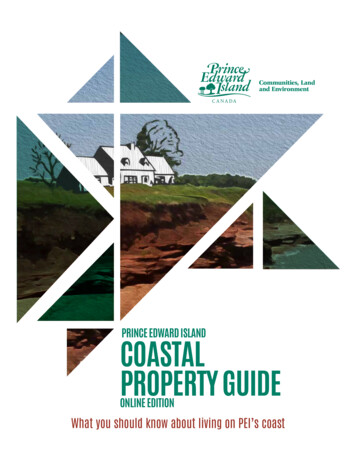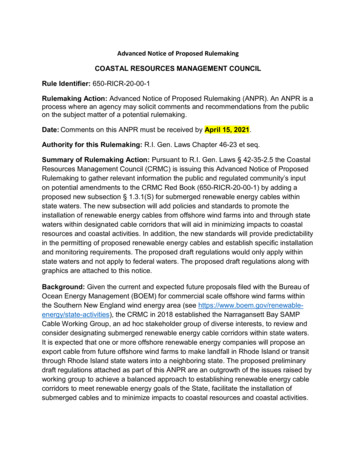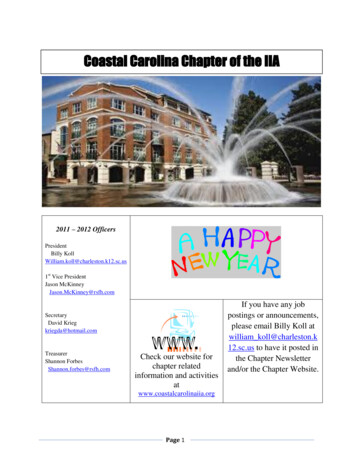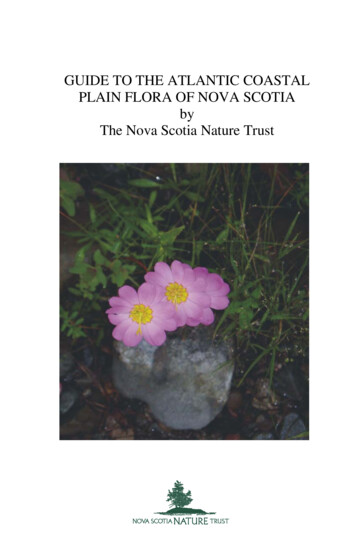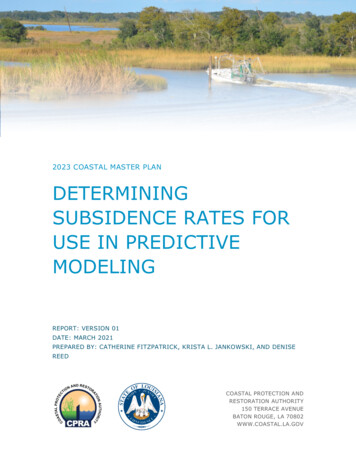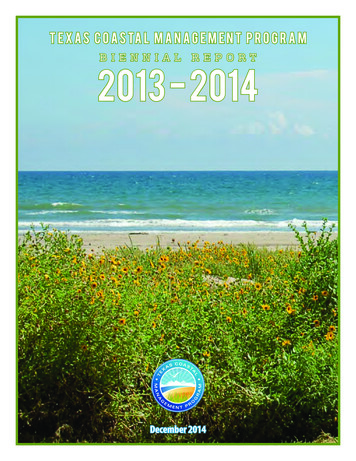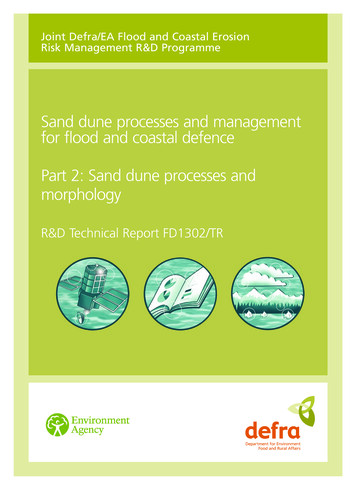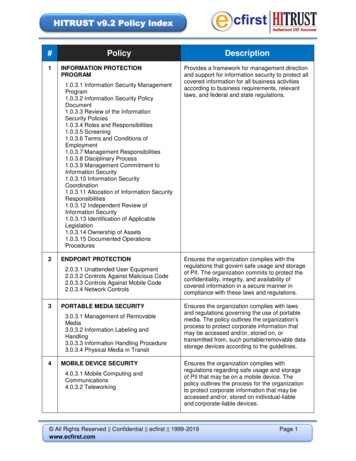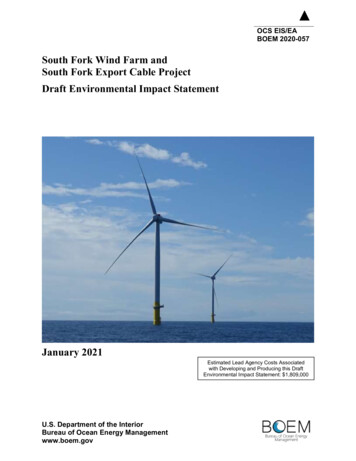
Transcription
Policy 15: Management of Coastal Dune AreasChapter 1IntroductionThe Gold Coast City has the benefit of approximately 52 kilometres of beachfront to the Pacific Ocean.It offers some of the best and most popular surfing beaches in Australia and, accordingly, is a majortourist attraction and coastal recreation area.Naturally occurring beach ecosystems are dynamic and consist of tidal zones, fore dune and hinddune areas.Dunal areas are critical for the protection of beaches. They are natural ‘buffer zones’ that reduce theimpact of fluctuations of the shoreline and erosion by the sea.In some areas along the oceanfront, development has encroached upon the frontal dunal area,disturbing the natural balance between erosion and replenishment, with a consequent loss ofadequate beach areas in some locations.The provision and proper management of adequately sized dunal ‘buffer zones’ in urban and nonurban areas is the most effective means of protection against the loss of the City’s beaches.High quality coastal beaches backed by vegetated and stable dunal ‘buffer zones’; contribute to theecological and environmental integrity of the City, and offer a spectacular visual and naturalenvironment which is a primary tourist attraction.This policy focuses on reducing the impact of urbanisation on the dunal areas, on the reestablishment, maintenance and protection of the natural dunal areas remaining, and on managinghigh use public areas within dunal areas.Chapter 2PurposeThis policy should be read in conjunction with Local Planning Policy No.17 – Foreshore Rock WallDesign and Construction. It is intended that the policy will be educational and promotional ratherthan regulatory.The purpose of this policy is to:1.Promote the establishment and retention of appropriate vegetation as the preferred form ofdune stabilisation;2.Preserve the function and sustainability of natural dunal systems;3.Provide community guidance on sustainable dunal land use;4.Project a positive city image;5.For the benefit of present and future generations of the Gold Coast City community.This policy will be implemented through various areas of Council responsibility, including: Development Approvals; Council works programs; Community based rehabilitation programs; and as a promotional and educational tool to encourage the general public to maintain and care fordunal areas in an appropriate manner.Commenced 06/06/03Policy 15: Management of Coastal Dune Areas1 of 29
Chapter 3Objectives1.To ensure the retention and planting of appropriate vegetation to assist in:a)stabilising dunes to minimise impacts of cyclonic winds on the natural and builtenvironment adjacent to the active frontal dune area;b)preventing sand losses from wind erosion; andc)establishing a sustainable habitat and corridor for wildlife.2.To reinforce the visual amenity of the City’s beaches by:a)using appropriate vegetation in dunal areas; andb)education and promotion of good landscape design principles in establishing newvegetation in urban areas in, and adjacent to, dunal areas.3.To facilitate safe public access through public land within dunal areas by defining access waysand public areas that can be maintained to a high standard with minimal impact on naturalsystems.4.To consider the visual amenity and privacy requirements of beachfront residents.Chapter 41.0BackgroundThe Nature of ErosionSand dunes act as a long-term sand store to build offshore bars during major erosion events. Largewaves make ‘withdrawals’ from the dunal sand bank to build offshore, protective sand bars, and thensmall waves return this sand back to the visible beach. The general pattern is one of swift erosionduring storms, and a gradual return to the beach of the eroded material during quiet periods.Gold Coast City Council has measured the volume of sand seaward of the Foreshore Seawall and hasestimated that in 1995 this sand is less than necessary to buffer a 1:50 year storm. This means whena storm of this magnitude arrives, the Foreshore Seawall is likely to be exposed.Vegetation significantly influences the size and stability of dunal areas.Gold Coast City Council has traditionally aimed to achieve a ‘buffer’, in the form of stabilised vegetatedsand dunes, seaward of the Foreshore Seawall. Stabilised and vegetated sand dunes help to increasethe volume of sand available to build sand bars during erosion events, thus protecting the ForeshoreSeawall and the properties behind in large storm events.2.0The Importance of Native Dunal VegetationIn coastal areas, the foliage of plants can be burnt by high temperatures, salt-laden winds and rain,and also abraded by windblown sand. Species that can withstand these effects can actually benefitfrom onshore winds by intercepting wind-borne nutrients from the sea. These nutrients are depositedon the leaves of coastal plants and washed into the sand by the first showers of rain.Native dunal vegetation can provide a significant refuge and source of food for local and migratoryfauna species.Existing native dunal vegetation provides a seed bank of plants for future generations, thusmaintaining the natural biodiversity of the area.Native dunal grasses, especially Spinifex grass (Spinifex sericeous), facilitate dune growth bycolonising and trapping windblown sand and preventing it escaping the beach system.The long, deep and expansive root systems of native dunal plants help to minimise sand losses fromfrontal dune areas caused by wave attack during severe erosion events.The varying of height and density of native dunal species provides an effective buffer to minimise windeffects.Native dunal vegetation can withstand burial by wind-blown sand, a common occurrence in ActiveFrontal Dune Areas.Native dunal vegetation provides habitat and corridors for a wide range of insects, birds and other wildlife.Native dunal vegetation enhances the natural appearance, overall character and environmental qualityof the beach and dunal areas and, hence, the image of the City.2 of 29Policy 15: Management of Coastal Dune AreasCommenced 06/06/03
3.0Impacts of Inappropriate/ Non-Native Dunal VegetationHardy salt tolerant non-native dunal species are not desirable in actively forming Frontal Dune Areas.They can often displace native dunal vegetation due to their ability to grow aggressively, smothernative dunal species, and compete for available nutrients.When the dunal areas are stressed through erosion, non-native plant species can quickly die, leavingbare sand which can be prone to wind erosion.Invasive exotic plants that inhabit areas close to the shoreline can be spread along the coastline bycurrents and become invasive in other areas.Mown turf does not have the ability to trap wind-blown sand travelling just above the ground level. Theabsence of sand-trapping vegetation causes sand to be lost from the system. The natural, dynamicsystem of sand movement is therefore disrupted.The establishment of turf and the mowing of herbaceous vegetation stunts the growth of the sanddunes (height and width), and inhibits their capacity to act as long-term sand reserves. The result ofstunted dune growth can be seen clearly along the coastline. In areas where native dunal specieshave been encouraged, the replenishment of sand has resulted in well-formed dunes. In areas wherenative dunal species have not been encouraged, the dunes are poorly developed and contain smallreserves of sand to replenish the beach and provide protection from wave attack.Turf is not capable of withstanding sand burial. Buried turf is most likely to die off, leaving the dunalarea without vegetative stabilisation in erosion events. Mown turf should not encroach into ActiveFrontal Dune Areas.The acceptance and use of environmentally inappropriate exotic species within the dunal environmentcan reduce the natural heritage values of ocean front land, be detrimental to the sustainability of thedunal environment, and have a negative impact on the aesthetic value of our foreshores. The use ofexotic species in some areas is contrary to the Strategic Planning Objectives to preserve the characterof foreshore/ beachfront areas and their contribution to the image of the City.4.0Impact of Human/ Urban ActivityCoastal sand dunes in urban areas are affected significantly by the activities of humans. Suchactivities include recreational use, establishment of environmentally inappropriate exotic vegetation,roads, car parks, beach access tracks, waste disposal and housing. Dunes and the plants that grow inthem have a limited capacity to recover from intensive use without assistance and care from thecommunity.Commenced 06/06/03Policy 15: Management of Coastal Dune Areas3 of 29
Chapter 5Management Units Within Coastal Dune AreasBecause of the ever changing nature of the dunal environment through natural occurrences, theimpact of human activity and recreational use, the Coastal Dune Areas have been categorised intothree broad management units. Clear guidelines and management practices can then be establishedto identify appropriate activity, use and vegetation within specific areas.These broad Management Units are:1.Non-Urban Dune Areas (for details, refer Clause 1.0)2.Urban Dune Areas (for details, refer Clause 2.0)3.Public Areas (for details, refer Clause 3.0)a)Minor Public Areasb)Major Public AreasThe locations of these Management Units have been identified by the Gold Coast City Council on theseries of mapped information titled, ‘Dunal Management Plans’. A copy of these plans is availablefrom the Gold Coast City Council on request. The information on these plans is continually updated byCouncil’s Managing Authority to reflect the current state of the dunal environment.Note:Refer to Appendix 3 for typical examples of the: ‘Dunal Management Unit Plan’; and ‘Active Frontal Dune Line Plan’.1.0Non-Urban Dune AreasWithin areas identified as Non-Urban Dune Areas on Gold Coast City Council ‘Dunal ManagementPlans’, the following requirements apply:a)Intentb)Activity and Use Requirementsc)Vegetation RequirementsIn addition, Basic Management Guidelines for rehabilitation and control of environmental weeds areprovided in Chapter 7 of this policy.The types of problems encountered when managing coastal sand dunes in Non-Urban Areas aredifferent from those encountered when managing dunes in Urban Dune Areas and Public Areas.Some of the problems experienced are: uncontrolled beach erosion and wind erosion; unnecessary access and use for recreational purposes; damage to land by future development that may be planned nearby; and damage to areas of conservation value.1.1IntentTo ensure that all Non-Urban Dune Areas are managed and maintained to protect existing naturalsystems and, where necessary, to rehabilitate degraded environments to replicate locally occurringnatural systems.1.21.2.1a)b)c)4 of 29Activity and Use RequirementsPolicy ProvisionsAny rehabilitation or maintenance programmes, including community rehabilitation programs,are to be undertaken only with approval from Council’s Managing Authority.Any practice or activity that destroys natural or native dunal species is unacceptable. Thisincludes uncontrolled vehicle use, high impact recreational use, and grazing by horses andintroduced stock. The natural and native dunal vegetation should be left intact to maintainstability against wind and beach erosion and to inhibit potential invasion by weed species.In some Non-Urban Dune Areas, it may be necessary to construct access ways for the use ofvehicles and pedestrians. The construction, type and location of any access ways is to beundertaken using best management practices, as required by Council’s Managing Authority.Policy 15: Management of Coastal Dune AreasCommenced 06/06/03
1.31.3.1a)b)c)1.4Vegetation Requirements for Non-Urban Dune AreasPolicy ProvisionsAny planting, modifying (including pruning and shaping) or removal of native species (includingnative dunal species) requires the approval of Council’s Managing Authority.Species identified in Chapter 6 of this policy are not appropriate for use in any new plantingworks, and those species already existing in these areas should be eradicated prior torehabilitation of the area with appropriate native dunal species.Best Management Practices shall be used when eradicating weed infestation so that areastreated do not become vulnerable to wind erosion. Any community rehabilitation programs areto be approved by Council's Managing Authority. Control of environmental weeds and exoticspecies is critical in these areas. Invasion of weeds and introduced species has detrimentaleffects on the stability and formation of dunes including: competition with, and displacement of, native dune vegetation; displacement of native fauna; increased fire risk.Vegetation GuidelinesVegetation communities vary landward across Non-Urban Dune Areas due to: decreases in the degree of exposure to salt spray, strong winds and sandblast; improvement in nutrient status and moisture content in developing dunes; and impacts from recreational use and historical land uses.The aggregation of vegetation communities in these areas form, in general terms, three zones –Pioneer, Woodland/ Scrub and Forest/ Heath zones. The dunes are dynamic in nature, and not allvegetation zones may be present due to the effect of extreme conditions.The three zones generally present in non-urban areas are described as follows:1.4.1Pioneer ZonePrimary stabilising plants consisting mostly of herbaceous and grass species.The pioneer zone usually extends landward from the debris line on the beach to the crest of the frontaldune. Where the beach is eroding, this zone may be completely absent. Conversely, where areas areaccreting rapidly, the pioneer zone may cover the berm and the whole of the frontal dune.Pioneer plants constitute the initial vegetation which colonises newly developing sand accumulations,and may eventually be replaced by grassland, scrubland, coastal heath, woodland, forest or wetland.Pioneer plants do not complete the stabilisation process, but prepare the dune soil and other habitatconditions for establishment of secondary stabilisers. These plants are critical for initial stabilisation ofsand.Some typical species that may inhabit this area are identified in Appendix 1 – Plant Schedule 6.1.4.2Woodland or Scrub ZoneSecondary stabilising plants including herbs, grasses, vines and stunted trees.The Woodland Zone usually covers the crest of the frontal dune, and may extend further inland toinclude the secondary dune. As the soil conditions improve and habitat conditions such as salt sprayand sand blast are reduced, pioneer plants may be replaced by secondary stabilising species of thewoodland zone. Most plants in these areas can withstand salt spray and salinity, but are damaged byhigh concentrations of these. Tree or shrub species may become stunted due to exposure to extremeconditions. The main function of this zone is to stabilise the accumulated sand and generally improvesoil conditions to enable a wider range of plant species to establish later.Some typical species that may inhabit this area are identified in Appendix 1 – Plant Schedule 7.Commenced 06/06/03Policy 15: Management of Coastal Dune Areas5 of 29
1.4.3Forest or Heath ZoneTertiary stabilising vegetation usually the same species as the woodland zone.The forest or heath zone is usually located landward of the woodland zone on the frontal dune tosheltered hind dune areas. This zone represents the mature state of development of coastalvegetation. Sometimes this zone is not present, due to excessive exposure to strong winds, salt sprayand other adverse environmental conditions. Generally, in low-lying areas typical of the Gold CoastCity, heath land has developed instead of forest.The main function of the forest zone is to stabilise hind dune areas by holding the sand in place,providing a habitat for flora and fauna diversity, and providing an important transition zone betweenthe sea and the inland zone. If severe erosion occurs and the forest zone becomes exposed toextreme conditions, vegetation may die, leaving the area exposed to wind erosion. It is critical that thearea be stabilised with pioneer plants to initiate the process of redevelopment of the vegetation zone.Some typical species that may inhabit this zone are identified in Appendix 1 – Plant Schedule 7 andPlant Schedule 8. These species are usually the same as in the woodland zone, but can become fullydeveloped and mature in favourable conditions.2.0Urban Dune AreasWithin areas identified as Urban Dune Areas on Gold Coast City Council ‘Dunal Management Plans’,the following requirements apply:Zone A2.1.1 – Intent2.1.2 – Activity and Use Requirements in Zone A2.1.3 – Vegetation Requirements in Zone AZone B2.2.1 – Intent2.2.2 – Activity and Use Requirements in Zone B2.2.3 – Vegetation Requirements in Zone BZone C2.3.1 – Intent2.3.2 – Activity and Use Requirements in Zone C2.3.3 – Vegetation Requirements in Zone CIn addition, Basic Management Guidelines for rehabilitation and control of environmental weeds areprovided in Chapter 7 of this policy.Note:The requirements and guidelines for Urban Dune Areas are to be read inconjunction with the GCCC ‘Dunal Management Plans’. Identified on these plansare the locations of the Foreshore Seawall Wall Line A, the Property Boundary andthe location of the Active Frontal Dune Line.Generally, Urban Dune Areas are those which are seaward of private residences, resort propertiesand all urban public park areas that have frontages to ocean beaches.High Seas and Wave Overtopping Erodes Frontal Dune Areas in Severe Storms6 of 29Policy 15: Management of Coastal Dune AreasCommenced 06/06/03
Issues associated with the management of Urban Dune Areas are complex due, to the proximity ofadjacent development and associated activity. Some of the issues involved are: urban development encroaching on what were once active frontal dune areas; removal or pruning of native dunal species to create views and gardens, destabilising duneareas; encroachment of turf and inappropriate vegetation into public land and actively forming duneareas; uncontrolled access in actively forming dune areas, resulting in instability and disruption to duneformation; wind erosion resulting from the loss of appropriate vegetation heights and arrangements; susceptibility of private property and urban parkland to damage during an erosion event; perceptions that public land is private or inaccessible.To facilitate clear and consistent management guidelines for use, activity and vegetation in UrbanDune Areas, typical zones have been identified. A diagram of Typical Zones within Urban Dune Areasis shown on the following page.The zones are identified as: Zone A – Active Frontal Dune Areas (always present); Zone B – Hind Dune Areas (sometimes present); Zone C – Property landward of the Hind Dune Line (always present).Note:2.1In some locations within Urban Dune Areas, the dunes have not matured to thestage where there is any stable land seaward of the hind dune line. In this instance,there are no hind dune areas present. Placement of the Active Frontal Dune Line isbased on assessment of the health and maturity of the dunal system.Zone A – Active Frontal Dune AreasNaturally occurring Active Frontal Dune Areas are characterised by sand dunes with ground and shrublevel vegetation. The Active Frontal Dune Area acts as a barrier and front line defence against theaction of tides and waves, as well as a long-term sand store for the beach during erosion events.The Active Frontal Dune Area has been identified as an area seaward of the Active Frontal Dune Line.The Active Frontal Dune Line represents the boundary between the dynamic frontal dune area and themore stable hind dune area. Determination of the location of this line is largely based on the conditionof the dunal system within neighbourhood block areas.The location of the Active Frontal Dune Line is assessed, having regard to: previous experience gained in managing dunal areas; and the state of the vegetation on the dune, and the penetration of wind blown sand particlesthrough buffers.The Active Frontal Dune Area is dynamic in nature and is at the mercy of climatic influences. Thelocation of the Active Frontal Dune Line may change from time to time in response to these climaticinfluences. For example, after an erosion event, some Active Frontal Dune Areas may be locatedfurther landward by Council’s Managing Authority to encourage quicker accretions of sand resourcesor, conversely, as these areas begin to stabilise, then the Active Frontal Dune Area may be locatedfurther seaward.Active Frontal Dune Areas are sensitive to damage, so it is essential that negative impacts onvegetation and dune formation are reduced to a minimum.Commenced 06/06/03Policy 15: Management of Coastal Dune Areas7 of 29
Typical Zones Within Urban Dune Areas8 of 29Policy 15: Management of Coastal Dune AreasCommenced 06/06/03
2.1.1IntentTo ensure that Active Frontal Dune Areas are managed and maintained in a manner which replicatesas closely as possible typically occurring natural local conditions.2.1.2Activity and Use Requirements for Zone APolicy Provisionsa)b)c)d)All Active Frontal Dune Areas, including those on public and private property, must be fenced toexclude human activity, except where access ways have been approved by Council’s ManagingAuthority. The required fencing may consist of a full back and front fence and possibly sidefences. Fencing is to be in accordance with Local Planning Policy No. 7 – Foreshore RockWall Design and Construction.Access ways to the beach must be no more than a single access way per property to the beach.Access ways are to be constructed to minimise wind and water run-off erosion. The method andlocation is to be determined by Council’s Managing Authority. Use of shared/ neighbouringaccess ways is encouraged to reduce impact.Nourishment of Active Frontal Dune Areas with clean sand is acceptable, provided these areasare revegetated to comply with the Vegetation Requirements in Subclause 2.1.3 of this policy.All sand used for nourishment must be sourced from outside the active beach system and befree of deleterious material, seeds and weed species. Written approval is required fromCouncil’s Managing Authority, prior to placement of any sand.The following activities and uses are not permitted in Zone A: any activity which, in the opinion of Council’s Managing Authority, may lead to wind,water run-off or sea erosion, will intensify recreation and uncontrolled access to thebeach or reduce the amenity of the beach; the laying of turf areas or mowing of dunal grasses; alteration of the natural configuration of the land, except where written approval has beengranted from Council’s Managing Authority to deposit clean sand for replenishment of theActive Frontal Dune area; Use of composting material and topsoil; dumping of any garden refuse; the construction of planting beds; and permanent irrigation systems.All lighting structures for private use must be located within private property. Any lighting of beachareas must not exceed the brightness of street lighting when viewed from the high water mark at anyparticular location.2.1.3Vegetation Requirements in Zone APolicy Provisionsa)b)c)d)e)Any planting of vegetation and/or removal of natural or native dunal species in the ActiveFrontal Dune Area (Zone A) requires written approval from Council’s Managing Authority. Theapplication should be accompanied by a plan showing the location and description of proposedspecies to be planted or removed.Planting or seeding of vegetation is to be undertaken using local native dunal species only.Plant stock is to be procured from locally propagated stock sources. Seed stocks are to beharvested from local seed bearing species.Species identified in Chapter 6 of this policy are not appropriate for use in any new plantingworks, and those species already existing in these areas should be eradicated prior torehabilitation of the area with appropriate native dunal species.Best Management Practices shall be used when eradicating weeds so that areas treated do notbecome vulnerable to wind erosion.Initial stabilisation of Active Frontal Dunal areas is to be achieved using locally obtained sandSpinifex (Spinifex sericeous) runners. Gold Coast City Council has approved locations forsourcing Spinifex runners for initial stabilisation purposes.Commenced 06/06/03Policy 15: Management of Coastal Dune Areas9 of 29
Spinifex runners should have a minimum length of 750 mm. A minimum of three (3) nodes shall beplanted parallel to the water line at 500 mm centres. Rows are to be 1000 mm apart. The runnersshould be planted vertically, to a minimum depth of 450 mm, with approximately 125 mm of the tip(growing end) exposed. Striking is expected to occur within 2 – 3 weeks, at which time the first of 3applications of Crop King 600 fertiliser shall be made. The 2 subsequent applications are to be made 3and 6 months after the first application.The planted area may be covered with brush matting. The matting should be spread thinly to avoidsmothering the Spinifex, but at a sufficient density to act as a sand trap. No limb shall be greater than50 mm diameter.After the successful establishment of Sand Spinifex (Spinifex sericeous), other ground, shrub and treespecies may be planted as secondary stabilisers. Appendix 1 – Plant Schedules 1 and 2 identifiessome appropriate species for planting in Active Frontal Dune Areas. These Schedules include plantdescriptions and appropriate locations within the Active Frontal Dune area.Vegetation GuidelinesThere are several different vegetation types that inhabit naturally occurring Active Frontal Dune areas.These are: Initial Stabilisers/ Pioneer PlantsThese plants are the initial vegetation which can colonise newly developed sand accumulations.These plants may eventually be replaced during the development of the dune, by scrubland, coastalheath or woodland. Pioneer plants do not generally complete the stabilisation process, but theyprepare the dune soil and other habitat conditions for establishment and growth of other vegetationtypes. It is critical at this stage in the stabilisation process that weed infestation is controlled. Herbaceous Plants and Dunal GrassesThese plants play a dominant role in dune formation. They grow in a manner that enables them to helpdevelop dunes in conjunction with wind action. Most of these plants have strong underground rootsystems and surface runners. ShrubsAfter initial stabilisation, shrubs act as a low-level windbreak and mound builder, but can alsointroduce some variety of wildlife habitat, colour, form and texture to the dunal areas. Shrubs providethe best effect when planted in groups of three to five and arranged to replicate naturally occurringgroups of vegetation. Shrubs are ideally located at either the upper/ crest of the seaward slope or inthe sheltered areas behind the crest of the Active Frontal Dune Area. TreesTrees can make a basic framework in the dunal area by providing higher windbreaks and salt traps, aswell as habitat, visual buffer or screen and character, and by framing views and providing shade. Theyare usually found on the crest and upper part of the landward slope of the Active Frontal Dune area.2.2Zone B – Hind Dune AreasIn some locations, dune growth has progressed to the stage where there are some sheltered areaslandward of the Active Frontal Dune Area. The Hind Dune area includes all areas landward of theActive Frontal Dune Line and seaward of the Hind Dune Line. (The Hind Dune Line may be either theForeshore Seawall Line A or the Private Property Boundary, whichever is the most landward.)In these stabilised areas, access and passive recreational use will not adversely reduce the overallstability of the dunal area. Note that these areas provide long term sand reserves during erosionevents, so it is imperative that the appropriate vegetative cover be maintained to sustain the dune areain an erosion event and to hold in reserve enough frontal dune species to quickly rebuild frontal dunesafter erosion events.Naturally occurring Hind Dune Areas are characterised by relatively unbroken canopies of maturenative dunal species, including a variety of ground covers, shrubs and trees.2.2.1IntentTo ensure that Hind Dune Areas are managed and maintained wherever possible to replicate naturallocal conditions. However, due to the relative stability of the dunes, low-level passive recreation andpublic access ways are acceptable.10 of 29Policy 15: Management of Coastal Dune AreasCommenced 06/06/03
2.2.2Activity and Use Requirements for Zone BPolicy Provisionsa)b)c)d)e)2.2.3Any structures or vegetation that impede public access in Hind Dune Areas within Crown Landare not permitted. This means there should be no fences of any description, or deliberatelocation of planting beds/ vegetation that restrict direct public access and give the perceptionthat Crown Land is private property. Any planting works require approval in writing fromCouncil’s Managing Authority. The application should be accompanied by a plan showing thelocation of proposed fencing or vegetation.Nourishment of Hind Dune Areas with clean sand is acceptable, provided these areas arerevegetated to comply with the Vegetation Requirements in Subclause 2.2.3 of this policy. Allsand used for nourishment must be sourced from outside the active beach system, and be freeof deleterious material, seeds and weed species. Written approval is required from Council’sManaging Authority prior to placement of any sand in Hind Dune Areas.Selective mowing of native turf-forming plants is acceptable in Zone B.The following activities and uses are not permitted on Crown Land within Zone B: the use of composting material and topsoil; dumping of garden refuse; alteration of the natural configuration of land, exce
Commenced 06/06/03 Policy 15: Management of Coastal Dune Areas 1 of 29 Policy 15: Management of Coastal Dune Areas Chapter 1 Introduction The Gold Coast City has the benefit of approximately 52 kilometres of beachfront to the Pacific Ocean. It offers some of the best and most popular surfing beaches in Australia and, accordingly, is a major
